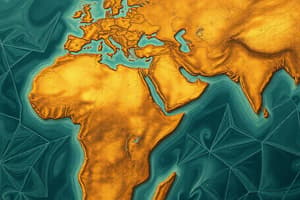Podcast
Questions and Answers
What factor is primarily responsible for the separation of continents in earth's history?
What factor is primarily responsible for the separation of continents in earth's history?
- Volcanic activity
- Tectonic plate movement
- Continental drift (correct)
- Asteroid impacts
What is the term for the helium nucleus in the nuclear equation?
What is the term for the helium nucleus in the nuclear equation?
- A neutron
- An alpha particle (correct)
- A gamma particle
- A beta particle
Approximately how old was the earth before the split of the continents?
Approximately how old was the earth before the split of the continents?
- 200 million years old
- 500 million years old
- 4.5 billion years old (correct)
- 1 billion years old
Which piece of evidence is commonly used to support the theory that continents were once joined?
Which piece of evidence is commonly used to support the theory that continents were once joined?
Which statement about geological events and patterns is inaccurate?
Which statement about geological events and patterns is inaccurate?
What is the fossilization process where original material is dissolved and replaced with new materials called?
What is the fossilization process where original material is dissolved and replaced with new materials called?
Given that layers of sedimentary rock are observed to be tilted, what can be inferred about these rocks?
Given that layers of sedimentary rock are observed to be tilted, what can be inferred about these rocks?
Which principle allows for the correlation and relative dating of rock units?
Which principle allows for the correlation and relative dating of rock units?
What condition must be met for a process to effectively serve as a geologic clock?
What condition must be met for a process to effectively serve as a geologic clock?
Which method has yielded the most accurate estimate of the age of the Earth?
Which method has yielded the most accurate estimate of the age of the Earth?
Flashcards are hidden until you start studying
Study Notes
Earth's History and Continental Drift
- The separation of continents is attributed to continental drift.
- Evidence for the continents once being joined includes fossils and the similarity of mountain ranges across different continents.
Radioactivity and the Geologic Clock
- Radioactive isotopes decay at a constant rate, providing a way to measure the age of rocks and fossils.
- The half-life of a radioactive isotope is the time it takes for half of the radioactive atoms to decay.
- Radiometric dating determines the absolute age of a rock by measuring the ratio of parent to daughter isotopes.
The Geologic Time Scale
- The geologic timescale is a representation of Earth's history divided into eons, eras, periods, and epochs.
- Major extinctions mark the boundaries between eras, signifying significant changes in life forms on Earth.
- The Precambrian is the longest time span on the geologic timescale, representing the early history of Earth before the evolution of complex life.
Fossil Formation and Interpretation
- Fossils form through various processes, including preservation of skeletal remains, signs of activity, and soft parts by freezing.
- The replacement process involves the original material being dissolved and replaced with new materials.
- Index fossils are used for correlation, allowing geologists to match similarly aged rocks from different locations.
Key Concepts in Stratigraphy
- Stratigraphy is the study of layered rocks and their relationships, providing information about Earth's history.
- Stratigraphic sequences are vertical sets of strata, representing the chronological record of a region's geology.
- Unconformities represent gaps in the geologic record, indicating periods of erosion or non-deposition.
- Nonconformities specifically represent an erosional surface between metamorphic or igneous rocks and overlying sedimentary rocks.
The Paleozoic Era
- The Paleozoic Era spans from 541 million to 251.9 million years ago.
- Key periods in the Paleozoic include the Ordovician, Mississippian, and Permian.
Dating Techniques and Limitations
- Potassium-Argon (K-Ar) dating measures the time since a mineral last cooled below a specific temperature, based on the decay of potassium to argon.
- Stratigraphy alone cannot always accurately determine the absolute ages of rocks.
- Factors like varying sedimentation rates and incomplete records limit the precision of stratigraphic dating.
Studying That Suits You
Use AI to generate personalized quizzes and flashcards to suit your learning preferences.




